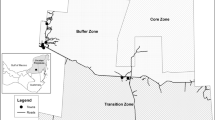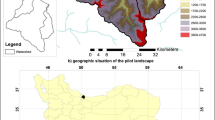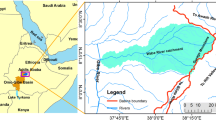Abstract
A dynamic bio-economic model has been used at watershed level in Nepal to analyze the land-use changes, forest and soil conditions and their resultant impacts on carbon (C) sequestration. Planning horizon of the model extends over a period of 25 years. The objective function is maximization of the sum of discounted net income flows from agriculture, livestock and forestry productions; imputed value of leisure and labour hiring out activities subject to annual constraints on land, labour and capital availability along with the fulfilment of minimum cash and consumption requirements. The seven scenarios analyzed by the model are: business as usual (BAU), reduction in population growth rate from 2 to 1.5% p.a., increased prices of major crops by 10 and 20%, reduction in emigration of active labour force from the watershed from the current rate of 20–15 and 10%, and increase in discount rate from 5 to 10%. The results indicate that reduced labour emigration rates and increase in the prices of major crops lead to expansion of cultivated area and shift from one land use to the others. Land clearing becomes more severe with decline in labour emigration rate. Up to 10% increase in the prices of agricultural crops does not have noticeable effect on total land clearing. Increase in discount rate leads to less land clearing, more biomass harvesting and higher net C sequestration as compared to the BAU scenario. Assuming a C price of 10 USD per MgC and 5% discount rate, the net present value of C sequestration for the first 25 years is estimated at 1.83 mill USD in the BAU scenario, varying from 0.16 mill USD to 2.26 mill USD, as respectively the lowest and highest values for the seven scenarios analysed. A reduction in population growth and maintenance of current rate of off-farm employment are suggested for slowing down the expansion of cultivated land area, and thereby reducing the forest/soil degradation and C emissions. This in turn would enhance the income potential from C sequestration.
Similar content being viewed by others
References
Angelsen A. (1999) Agricultural expansion and deforestation: Modelling the impact of population, market forces and property rights. Journal of Development Economics 58: 185–218
Annapurna Conservation Area Project (ACAP). (1996). A baseline survey of Lwang Ghalel conservation unit. Pokhara: ACAP Head Quarter.
Awasthi, K. D. (2004). Land use change effects on soil degradation, C and nutrient stocks and greenhouse gas emission in mountain watersheds. Ph.D. thesis no 35, Agricultural University of Norway, Norway.
Bajracharya D. (1983) Fuel, food or forest? Dilemma in a Nepali village. World Development 11: 1057–1073
Banskota M. (2000) The Hindu Kush–Himalayas: Searching for viable socio-economic and environmental options. In: Banskota M., Papola T. S., Rischter J. (eds) Growth, poverty alleviation and sustainable resource management in the mountain areas of South Asia. ICIMOD, Kathmandu
Brooke, A., Kendrick, D., & Meeraus, A. (1996). GAMS release 2.25: A user’s guide. Washington: GAMS Development Corporation.
Carter A. S., Gilmour D. A. (1989) Increase in tree cover on private farmland in Central Nepal. Mountain Research and Development 9: 111–134
Central Bureau of Statistics (CBS). (2001). National population census: District report. Kathmandu: CBS.
Chambers R. (1994) The origins and practice of participatory rural appraisal. World Development 22: 953–969
Fox J. M. (1993) Forest resources in a Nepali village in 1980–1990: The positive influence of population growth. Mountain Research and Development 13: 89–98
HMG/ADB/FINIDA. (1988). Master plan for the forestry sector Nepal, Annex 3. Kathmandu: Ministry of Forests and Soil Conservation.
Hoen H. F., Solberg B. (1994) Potential and economic efficiency of carbon sequestration in forest biomass through silvicultural management. Forest Science 40(3): 429–451
Hoen, H. F., & Solberg, B. (1995). On “valuation of global afforestation programs for carbon mitigation” by Sten Nilsson. An editorial comment. Climatic change, 30, 259–266.
Hoen, H. F., & Solberg, B. (1999). Policy options in carbon sequestration via sustainable forest management: An example from the north. In M. Palo (Eds.), Forest transitions and carbon fluxes. World development studies (Vol. 15, pp. 117–132). Helsinki: The United Nations University, World Institute for Development Economics Research.
Hofstad, O. (1997). Woodland deforestation by charcoal supply to Dar es Salaam. Journal of Environmental Economics and Management, 33, 17–32.
Holden S. T., Shiferaw B. (2004) Land degradation, drought and food security in a less-favored area in the Ethiopian highlands: A bio-economic model with market imperfections. Agricultural Economics 30(1): 31–49
IPCC. (2000). The Intergovernmental Panel on Climate Change, special report on land use, land-use change, and forestry. Cambridge: Cambridge University Press.
Kaimowitz D., Angelsen A. (1998) Economic models of tropical deforestation: A review. Centre for International Forestry Research, Jakarta
Kerr S., Liu S., Pfaff A. S. P., Hughes R. F. (2003) Carbon dynamics and land-use choices: Building a regional-scale multidisciplinary model. Journal of Environmental Management 69: 25–37
Kruseman, G. (2000). Bio-economic household modeling for agricultural intensification. PhD thesis, Wageningen University, Wageningen.
Lal R. (1999) World soils and greenhouse effect. Global Change News Letter 37: 4–5
Lal R. (2003) Soil erosion and the global carbon budget. Environment International 29: 437–450
Lal R., Kimble J., Whitman C. (1995) World soils and greenhouse effects: An overview. In: Lal R., Kimble J., Stewart B. A. (eds) Soils and global change. CRC Press, Boca Raton, FL
Lewandrowski, J., Peters, M., Jones, C., House, R., Sperow, M., Eve, M., & Paustian, K. (2004). Economics of sequestering carbon in the U.S. agricultural sector. Economic Research Service, Research Brief. U.S. Department of Agriculture, USA.
Okumu B. N., Jabbar M. A., Colman D., Russell N. (2002) A bio-economic model of integrated crop-livestock farming systems: The case of Ginchi watershed in Ethiopia. In: Barrett C. B., Place F. M., Aboud A. A. (eds) Natural resources management in African agriculture: Understanding and improving current practices. CAB International, Wallingford
Paudel, G. S. (1997). Integration of forest and rangeland management for livestock development in the hills of Nepal. Dissertation (M.Sc.) NR 97-16, AIT, Bangkok, Thailand.
Pfaff A. S. P., Kerr S., Hughes R. F., Liu S., Sanchez-Azofeifa G. A., Schimel D., Tosi J., Watson V. (2000) The Kyoto protocol and payments for tropical forest: An interdisciplinary method for estimating cabon-offset supply and increasing the feasibility of a carbon market under the CDM. Ecological Economics 35: 203–221
Raymer, A. K. P. (2005). Modeling and analyzing climate gas impacts of forest management. PhD thesis 2005:11, Norwegian University of Life Sciences, Norway.
Sankhayan P. L., Hofstad O. (2001) A village-level economic model of land clearing, grazing, and wood harvesting for sub-Saharan Africa: With a case study in Southern Senegal. Ecological Economics 38: 423–440
Sedjo, R. A., Sohngen, B., & Jagger, P. (1998). Carbon sinks in the post-Kyoto world. RFF Climate Issue Brief No. 13, Internet Edition.
Sharma, E. R., & Pukkala, T. (1990). Volume equations and biomass prediction of forest trees of Nepal. Publication No. 47(1). Ministry of Forests and Soil Conservation, Forest Survey and Statistics Division, Kathmandu.
Simon, H. A. (1955). A behavioral model of rational choice. Quarterly Journal of Economics, 69, 99–118.
Singh S. P., Adhikari B. S., Zobel D. B. (1994) Biomass, productivity, leaf longevity, and forest structure in the central Himalaya. Ecological Monographs 64: 401–421
Solberg B. (1997) Forest biomass as carbon sink—economic value and forest management/policy implications. Critical Reviews in Environmental Science and Technology 27(special): S323–S333
Solberg B. (1998) Economic aspects of forestry and climate change. Commonwealth Forestry Review 77: 229–233
Upadhyay T. P., Sankhayan P. L., Solberg B. (2005) A review of carbon sequestration dynamics in the Himalayan region as a function of land use change and forest/soil degradation with special reference to Nepal. Agriculture, Ecosystems & Environment 105: 449–465
Upadhyay T. P., Solberg B., Sankhayan P. L. (2006) Use of models to analyse land-use changes, forest/soil degradation and carbon sequestration with special reference to Himalayan region: A review and analysis. Forest Policy and Economics 9: 349–371
Author information
Authors and Affiliations
Corresponding author
Rights and permissions
About this article
Cite this article
Upadhyay, T.P., Solberg, B., Sankhayan, P.L. et al. Land-use changes, forest/soil conditions and carbon sequestration dynamics: A bio-economic model at watershed level in Nepal. J Bioecon 15, 135–170 (2013). https://doi.org/10.1007/s10818-011-9123-z
Published:
Issue Date:
DOI: https://doi.org/10.1007/s10818-011-9123-z




